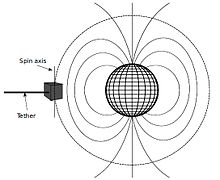User:Hannes993/sandbox
{{Infobox spacecraft
| Name = ESTCube-1
| Image = [[File:ESTCube-1 illustration.jpg|thumb|ESTCube-1 illustration]]
| Caption =
| Organization = [[University of Tartu]]
| Major_Contractors =
| Mission_Type = Technological experimentation
| Satellite_Of = [[Earth]]
| Launch = Spring 2013
| Launch_Vehicle = [[Vega (rocket)|Vega]]
| Decay =
| Mission_Duration = 12 months
| Mass = 1 kg
| NSSDC_ID =
| Webpage = estcube.eu[http://www.estcube.eu/en/home]
| Orbital_elements =
| Semimajor_Axis =
| Eccentricity =
| Inclination =
| Orbital_Period =
| Apoapsis =
| Periapsis =
| Orbits = [[low Earth Orbit]]
}}
ESTCube-1 is a satelite created by Estonian Student Satelite Projekt which is going to be put on orbid in the year 2013. Student Satellite is an educational project which will be done by university and high school students. During the engineering phase of the satellite cubesat standard for nanosatellites was followed. (mass 1,3 kg and cubage 1 liter as 10x10x10 cm)
Measurements and weight
[edit]By standard 1 unit (1U) cubesat base side lenght must be 100,0±0,1 millimeters and satellite height must be 113,5±0,1 mm According to the cubesat standard there are three different sized cubesats corresponding to size 1U, 2U and 3U. Base side lenghts are the same but height is 2 to 3 times bigger than 1U cubesats. Mass is also set in cubesat standard, the highest possibe mass for 1U cubesat is 1300 grams, 2U cubesat 2600 grams and 3U cubesat 4000 grams. During the developement of the Estonian satellite mission it was decided to make a 1U cubesat.
Scientific purpose
[edit]


Although during the creation of ESTCube-1 the main purpose was to educate students the satellite has a scientific purpose. On board the satellite is an electric solar wind sail (e-sail) which was created by an finnish scientist Pekka Janhunen, it is the first real experimentation of the e-sail. During the flight of the satellite 10 meters of e-sail 50 to 20 micrometers thick wire of hightechnology structure so called Heytether will be deployed from the satellite. The deployment of the Haytether can be detected by decresion of the satellites spinning velocity or by a onboard camera. To controll the loaded solar wind sail elements interaction with the plasma surrounding the earth and the effect it has on the spacecraft spinning speed the spacecraft has two onboard nanotechnologic electron emitters. The electron emitters are connected to the e-sail element and by shooting out electrons it loads the e-sail element positively to 500 volts. The positive ions in the plasma push the e-sail element and have an influence on the satellites rotation speed. The efect of the e-sail is measured by the change in rotation speed. After the mesurements on the e-sail efect are completed it is planned to use the Haytether as a plasmabreake by loading its ionosphere oposite to the plasmas ionosphere and demonstrate by it one possibility to return little satellites down form the orbit. Onboard the satellite is a color CMOS-sensor camera, which is capeable of making VGA-resolution RAW-format pictures. Kamera is used to take a picture of the earth and successfully deployed Haytether.
Satellites orbid
[edit]To complete the scientific experiment and communicate to the satellite on several ocasions the best orbit is sun–synchronous circular orbit on the altitude of 670 kulometers. ESTCube-1 will be sent to orbid by European Space Agencys rocket Vega in Spring 2013.
The lifespan of the satellite
[edit]- Start 2013 spring
- Half an hour after the satellites deploiment from thestart capsule satellites antennas will be opened and radiotransmitter and important subsystems will be swiched on
- First days or weeks will be will be used to test the satellite and set it to work on full capacity
- Orienting te satellite so the onboard camera will be faced to earth and with good luck trying to take a picture of Estonia.
- Rotating the satellite on an axis on speed 1 revolution per second
- E-sail element deployment from the satellite by a tsentrifugal force and confirming the deployment via the onboard camera.
- Activating the electron emitter and loading the e-sail
- Measuring the e-sails and Lorentz efect by satelites revolutions per second
- If possible using the negatively charged e-sail to take the satellite off orbid and burn it in the earths atmosphere.
If everything goes perfect the mission can be completed within a few weeks to a month.
Communicating with the satellite
[edit]Communicating with the satellite is done by two International Amateur Radio Unions three registred frequencis
- 437,250 MHz
- 437,505 MHz
Periodical but very slow communication is done on a telegraphic signal on a frequency 437,250 MHz. With that way the most important satellite parameters are transmitted every 3 to 5 minutes. For fast connections FSK-modulation radiosignal on a frequency 437.505 MHz with a 9600 bit connection speed and AX.25 standard is used. Somewhat slow connection speed is caused by usage of amateur radio frequencys which allow maximum of 25 kiloherz bandwidth. Besides FSK-modulation transmitter there is also GFSK-, MSK-, and GMSK-modulation signal transmitters. Using the GFSK-modulation maximum possible connection speed is 19 200 bits per second. Fast connection is used only when the satellite has been given a specific order. For giving orders to satellite amateur signal 145 MHz is used.
Softward
[edit]ESTCube-1 microcontrollers use the following operatingsystems:
- FreeRTOS satellites on-board computer and cameramodule
- TinyOS satellites COM-module BSD licence. For using with devices running on low power
- Mission Control System is currently being developed with a company CGI Group
Financing and costs
[edit]Cheapest possibility to send a satellite onto orbid is offered by European Space Agency. Because Estonia is an associated member of ESA most of the launch expences (~70 000 eur) will be covered from Estonian member fee for educational expences. With the launch total expences for the project is approximately 100 000 euro.
See also
[edit]- CubeSat - International CubeSat standard
- Aalto-1 - Finnish Aalto university nanosatellite project
- Eesti tudengisatelliidi programm - Estonian student satellite program
- List of CubeSats

